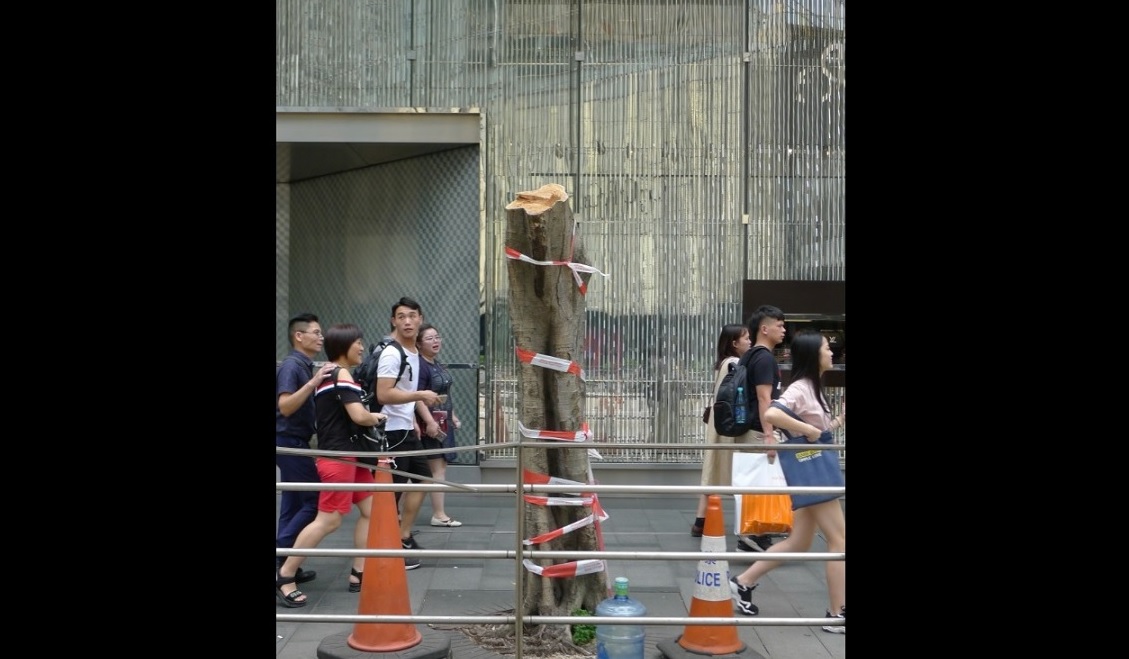Reviews & Articles
Winds of Inertia
John BATTEN
at 9:13am on 22nd November 2018

Caption:
Cut tree after Typhoon Mangkhut, Central Business District, Hong Kong, 20 October 2018.
Photograph: John Batten
(原文以英文發表,題為〈因循之風〉。)
The aftermath of Typhoon Mangkhut’s recent visit is still around us. Thousands of fallen trees remain waiting to be cleared; and, the management of trees whose branches have been cut and trimmed raises questions about the competence of those doing the tree maintenance.
A few weeks later, in the Chief Executive’s policy address, Mrs Lam announced that reclamation and artificial islands would be developed offshore of East Lantau, very near the small island community of Peng Chau. Meanwhile, the government’s own taskforce on land supply will release its final report in December. However, the report appears meaningless as the government has pre-empted its findings by opting for the East Lantau development. As critics have rightly pointed out, the East Lantau development cannot ease Hong Kong’s immediate housing woes. Building substantial transport and road infrastructure to service the government’s estimate of the million people living in this new town is essential and the required planning and construction will take many years.
Mrs Lam also announced the reintroduction of industrial building conversions to house families who are currently living in sub-standard housing. However, such an intervention will have repercussions by distorting the market for businesses requiring industrial work spaces – these businesses include food production factories, engineering and fabrication companies, warehousing for logistic companies, processing and office records storage, repair facilities for appliances, cars, electrical components, plumbing, air-conditioning and computer equipment. Without suitable and affordable industrial spaces, Hong Kong’s ability to be a fully functioning city will be severely restricted.
A more immediate solution for families living in sub-standard living conditions should be to use Education Department’s stock of vacant schools, numbering over 100, and located throughout Hong Kong. Classrooms could quickly be subdivided and re-provisioned as accommodation; bathrooms and kitchens could be converted from existing facilities. We know that government departments are highly protective of their resources and policy rarely crosses the boundaries of individual departmental responsibilities. So, education and housing are separate issues and government responses to housing will remain conservative: vacant schools will remain vacant.
The management of Hong Kong’s trees is similarly strangled by government inertia. Widely reported, photographed and shared after the typhoon were trees that had been planted in shallow ground, especially those planted at ground-level, as landscaping for large housing developments. These trees had fallen because tree roots had no room to spread as they had been restrained in shallow concrete pits, like planted in a pot placed underground. Above-ground, trees have been severely cut and trimmed and there has been little evidence of the necessary replanting of trees to replace those that had fallen.
If we can’t get the management of our trees right, how can government think they can successfully manage an environmentally-sensitive project as the construction of huge artificial islands off East Lantau?
This article was originally published in Perspective architectural magazine, November 2018.
原文刊於Perspective, 2018年11月。
